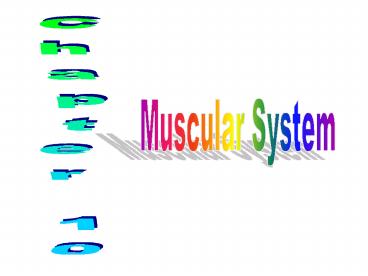Muscular System - PowerPoint PPT Presentation
Title: Muscular System
1
Chapter 10
Muscular System
2
Functional Classification of Muscles
- 1. Prime movers provide the major force for
producing a specific movement - 2. Antagonists oppose or reverse a particular
movement - 3. Synergists
- Add force to a movement
- Reduce undesirable or unnecessary movement
- 4. Fixators synergists that immobilize a bone
or muscles origin
3
Naming Muscles
- Location of muscle bone or body region
associated with the muscle - Shape of muscle e.g., the deltoid muscle
(deltoid triangle) - Relative size e.g., maximus (largest), minimus
(smallest), longus (long) - Direction of fibers e.g., rectus (fibers run
straight), transversus, and oblique (fibers run
at angles to an imaginary defined axis)
4
Naming Muscles
- 5. Number of origins e.g., biceps (two origins)
and triceps (three origins) - Location of attachments named according to
point of origin or insertion - Action e.g., flexor or extensor, as in the
names of muscles that flex or extend, respectively
5
Arrangement of Fascicles
- Parallel fascicles run parallel to the long
axis of the muscle (e.g., sartorius) - Fusiform spindle-shaped muscles (e.g., biceps
brachii) - Pennate short fascicles that attach obliquely
to a central tendon running the length of the
muscle (e.g., rectus femoris) - Convergent fascicles converge from a broad
origin to a single tendon insertion (e.g.,
pectoralis major) - Circular fascicles are arranged in concentric
rings (e.g., orbicularis oris)
6
(No Transcript)
7
Isotonic Contractions
- In isotonic contractions, the muscle changes in
length (decreasing the angle of the joint) and
moves the load - The two types of isotonic contractions are
concentric and eccentric - Concentric contractions the muscle shortens and
does work - Eccentric contractions the muscle contracts as
it lengthens
8
Isometric Contractions
- 1. Tension increases to the muscles capacity,
but the muscle neither shortens nor lengthens - 2. Occurs if the load is greater than the
tension the muscle is able to develop






























